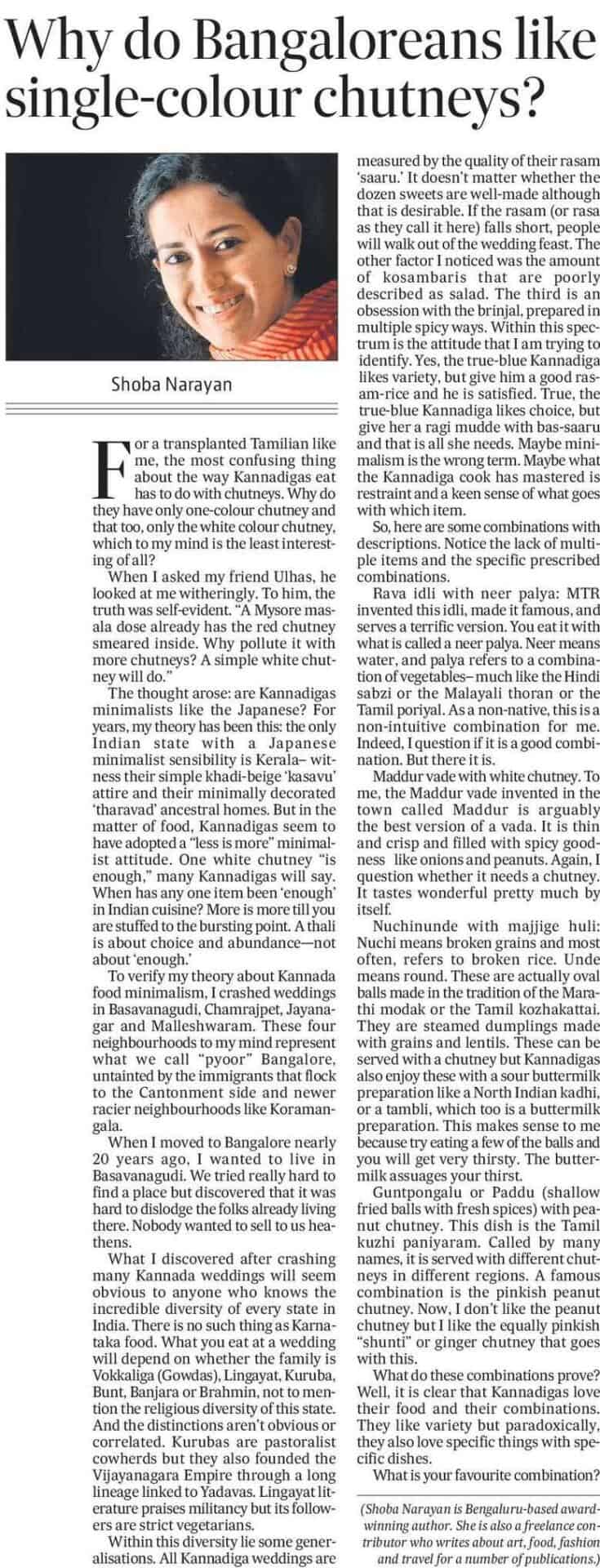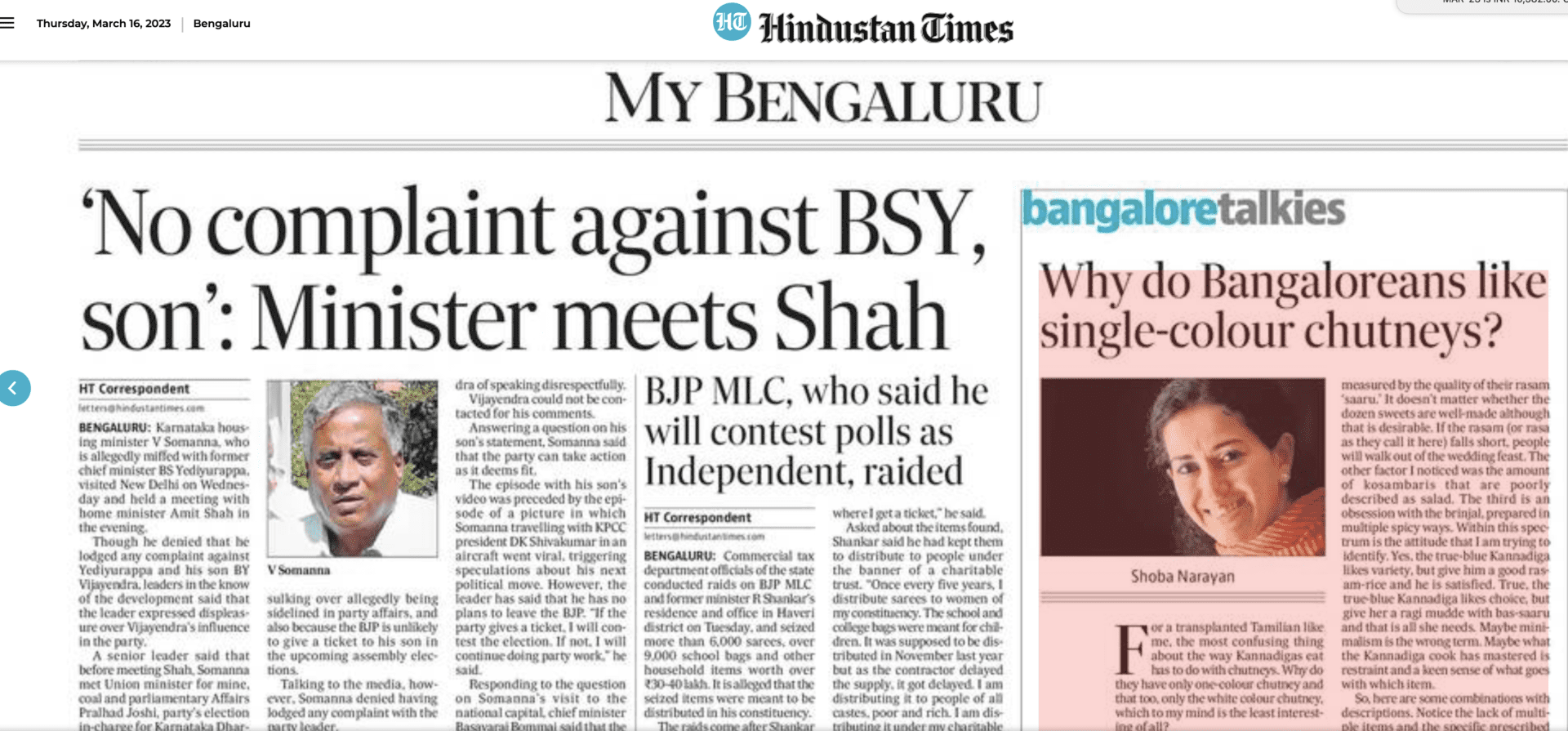For a transplanted Tamilian like me, the most confusing thing about the way Kannadigas eat has to do with chutneys. Why do they have only one-colour chutney and that too, only the white colour chutney, which to my mind is the least interesting of all?
When I asked my friend Ulhas, he looked at me witheringly. To him, the truth was self-evident. “A Mysore masala dose already has the red chutney smeared inside. Why pollute it with more chutneys? A simple white chutney will do.”
The thought arose: are Kannadigas minimalists like the Japanese? For years, my theory was that the only Indian state with a Japanese minimalist sensibility was Kerala– witness their simple khadi-beige ‘kasavu’ attire and their minimally decorated ‘tharavad’ ancestral homes. But in the matter of food, Kannadigas seem to have adopted a “less is more” minimalist attitude. One white chutney “is enough,” many Kannadigas will say. When has any one item been ‘enough’ in Indian cuisine? More is more till you are stuffed to the bursting point.

To verify my theory about Kannada food minimalism, I crashed weddings in Basavanagudi, Chamarajpet, Jayanagar and Malleshwaram. These four neighbourhoods to my mind represent what we call “pyoor” Bangalore, untainted by the immigrants that flock to the Cantonment side and newer racier neighbourhoods like Koramangala.
When I moved to Bangalore nearly 20 years ago, I wanted to live in Basavanagudi. We tried really hard to find a place but discovered that it was hard to dislodge the folks already living there. Nobody wanted to sell to us heathens.
What I discovered after crashing many weddings will seem obvious to anyone who knows the incredible diversity of every state in India. There is no such thing as Karnataka food. What you eat at a wedding will depend on whether the family is Vokkaliga (Gowdas), Lingayat, Kuruba, Bunt, Banjara or Brahmin, not to mention the religious diversity of this state. And the distinctions aren’t obvious or correlated. Kurubas are pastoralist cowherds but they also founded the Vijayanagara empire through a long lineage linked to Yadavas.
Within this diversity lie some generalisations. All Kannadiga weddings are measured by the quality of their rasam ‘saaru.’ It doesn’t matter whether the dozen sweets are well-made although that is desirably. If the rasam (or rasa as they call it here) falls short, people will walk out of the wedding feast. The other factor I noticed was the amount of kosambaris, that are poorly described as salad. The third is an obsession with the brinjal, prepared in multiple spicy ways. Within this spectrum is the attitude that I am trying to identify. Yes, the true-blue Kannadiga likes variety, but give him a good rasam-rice and he is satisfied. True, the true-blue Kannadiga likes choice, but give her a ragi mudde with bas-saaru and that is all she needs. Maybe minimalism is the wrong term. Maybe what the Kannadiga cook has mastered is restraint and a keen sense of what goes with which item.
Here then are some combinations with descriptions. Notice the lack of multiple items and the specific prescribed combinations.
Rava idli with neer palya: MTR invented this idli, made it famous, and serves a terrific version. You eat it with what is called a neer palya. Neer means water, and palya refers to a combination of vegetables– much like the Hindi sabzi or the Malayali thoran or the Tamil poriyal. As a non-native, this is a non-intuitive combination for me. Indeed, I question if it is a good combination. But there it is.
Maddur vade with white chutney. To me, the Maddur vade invented in the town called Maddur is arguably the best version of a vada. It is thin and crisp and filled with spicy goodness like onions and peanuts. Again, I question whether it needs a chutney. It tastes wonderful pretty much by itself.
Nuchinunde with majjige huli: Nuchi means broken grains and most often, refers to broken rice. Unde means round. These are actually oval balls made in the tradition of the Marathi modak or the Tamil kozhakattai. They are steamed dumplings made with grains and lentils. These can be served with a chutney but Kannadigas also enjoy these with a sour buttermilk preparation like a North Indian kadhi, or a tambli, which too is a buttermilk preparation. This makes sense to me because try eating a few of the balls and you will get very thirsty. The buttermilk assuages your thirst.
Guntpongalu or Paddu (shallow fried balls with fresh spices) with peanut chutney. This dish is the Tamil kuzhi paniyaram. Called by many names, it is served with different chutneys in different regions. A famous combination is the pinkish peanut chutney. Now, I don’t like the peanut chutney but I like the equally pinkish “shunti” or ginger chutney that goes with this.
What do these combinations prove? Well, it is clear that Kannadigas love their food and their combinations. They like variety but paradoxically, they also love specific things with specific dishes.





Interesting learning, for eating in Bengaluru!